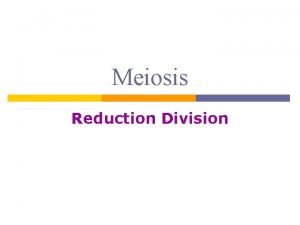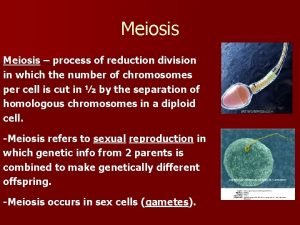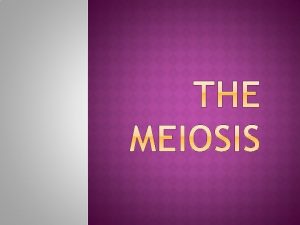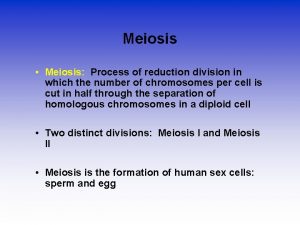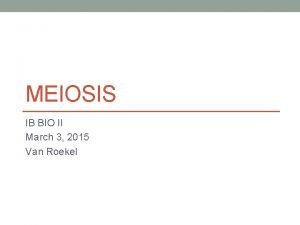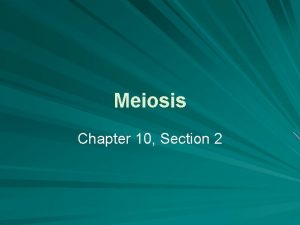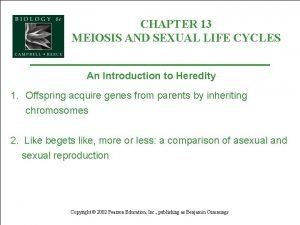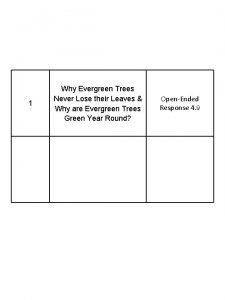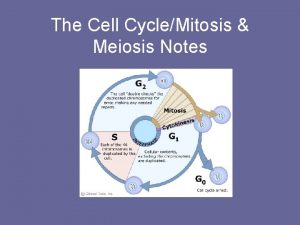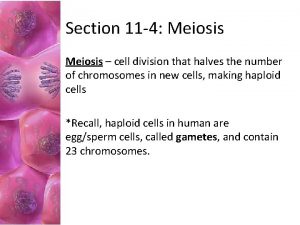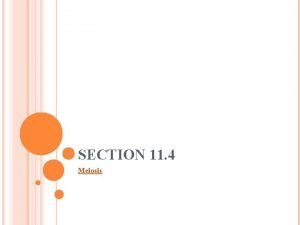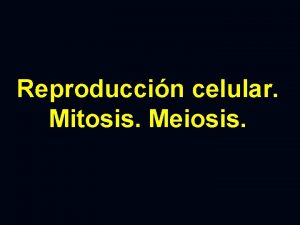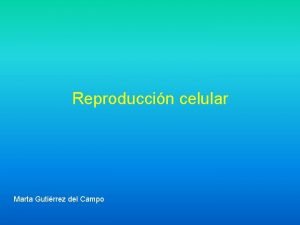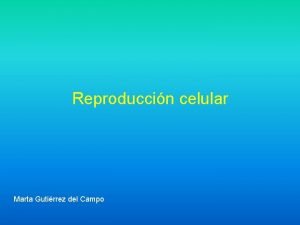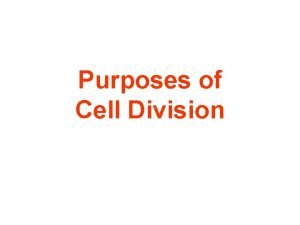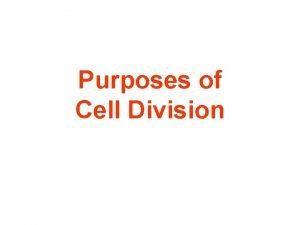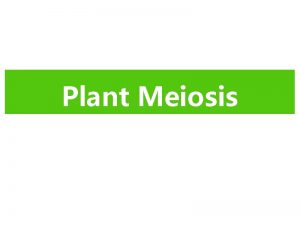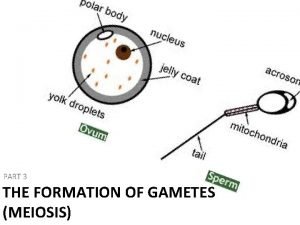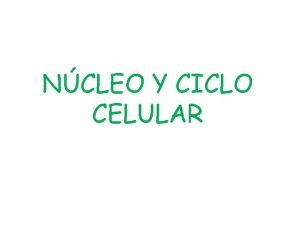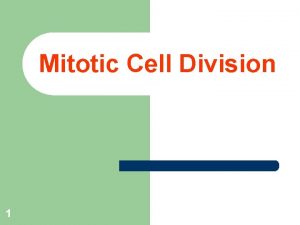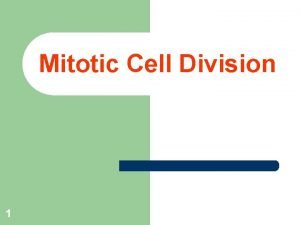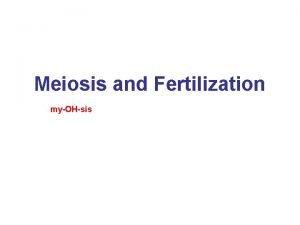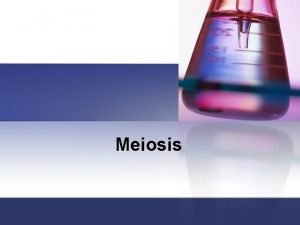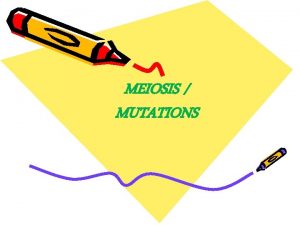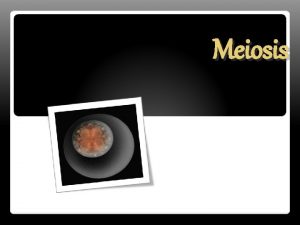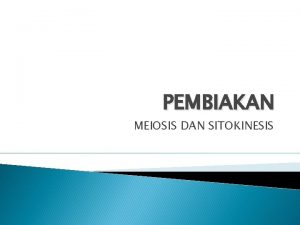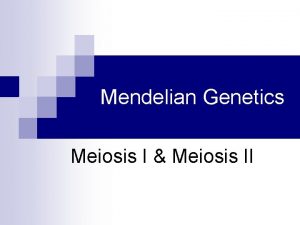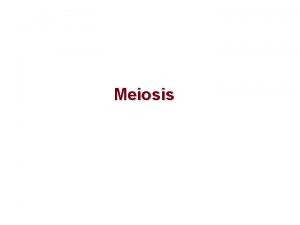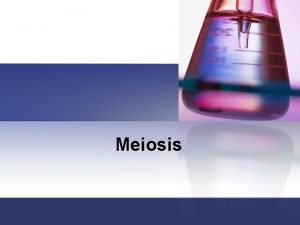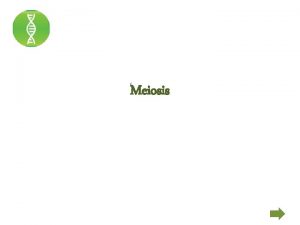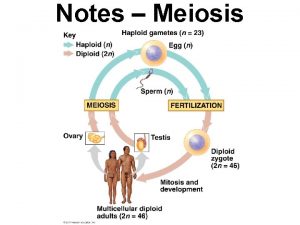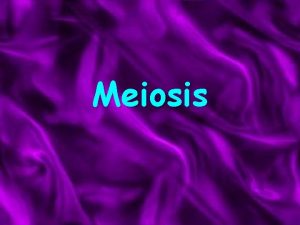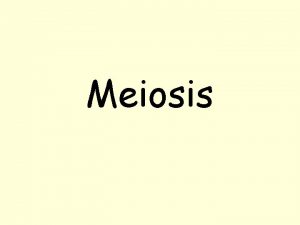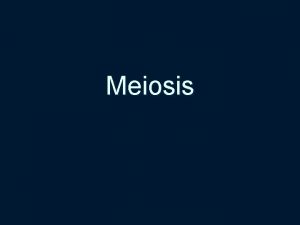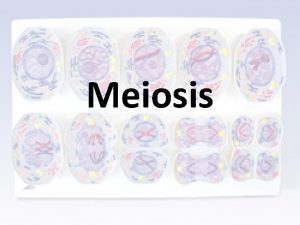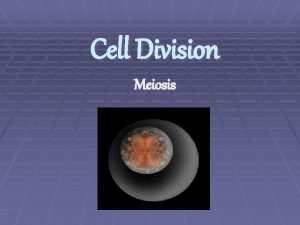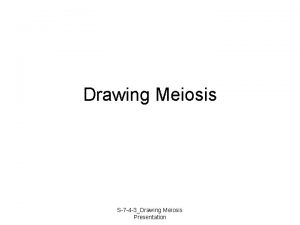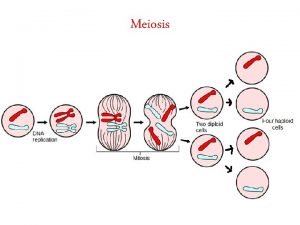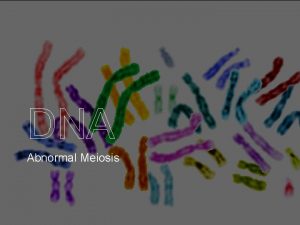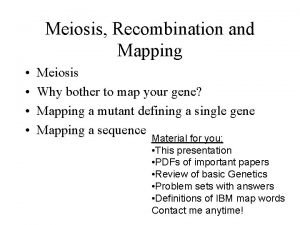Meiosis Chapter 13 Why meiosis n n n


















































- Slides: 50

Meiosis (Chapter 13)

Why meiosis? n n n Produces haploid cells. Genetic diversity Evolution

Mitosis n n n Two identical daughter cells Interphase Cell growth, preparing for cell division Prophase, Metaphase, Anaphase, Telophase Cytokinesis

Fig. 12 -4 0. 5 µm Chromosomes Chromosome arm Centromere DNA molecules Chromosome duplication (including DNA synthesis) Sister chromatids Separation of sister chromatids Centromere Sister chromatids

Fig. 13 -3 b 5 µm Pair of homologous replicated chromosomes Centromere Sister chromatids Metaphase chromosome

Meiosis n n n 2 successive rounds of cell division No replication of DNA between rounds Meiosis I Half the number of chromosomes Meiosis II 4 haploid cells

Meiosis n n n Each round of division has a Prophase Metaphase Anaphase Telophase


Fig. 13 -7 -3 Interphase Homologous pair of chromosomes in diploid parent cell Chromosomes replicate Homologous pair of replicated chromosomes Sister chromatids Diploid cell with replicated chromosomes Meiosis I 1 Homologous chromosomes separate Haploid cells with replicated chromosomes Meiosis II 2 Sister chromatids separate Haploid cells with unreplicated chromosomes

Meiosis n n n n Synapsis: Homologous chromosomes Closely associated Synaptonemal complex: Homologous chromosomes are paired Protein complex between them Occurs in prophase I

Meiosis n n n Crossing-over: Homologues exchange chromosomal information Genetic recombination: Chromosomes from one parent carry info from both Chiasma “cross” (plural: Chiasmata) Site where crossing-over happens

Cross-over n n Between non-sister chromatids Stabilized by sister chromatids





Prophase I n n n DNA coils tighter DNA already duplicated Sister chromatids joined at centromeres

Prophase I n n n Sister chromatid cohesion: Sister chromatids closely associate Homologous chromosomes line up next to each other Crossing over happens Non-sister chromatids

Prophase I n n Crossing over ends 4 chromatids (2 homologs) stay close due to 1. Sister chromatid cohesion 2. Chiasmata where crossover occurs

Metaphase I n n n Homologous pairs align beside each other Metaphase plate (center) Chiasmata holds homologous chromosomes together Maternal homologue orients towards one pole Paternal homologue orients towards other pole

Metaphase I

Fig. 13 -8 b Prophase I Metaphase I Centrosome (with centriole pair) Sister chromatids Chiasmata Spindle Centromere (with kinetochore) Metaphase plate Homologous chromosomes Fragments of nuclear envelope Microtubule attached to kinetochore

Anaphase I n n n 90% meiosis is spent in Prophase & Metaphase Spindle fibers begin to shorten Pull apart homologous chromosomes Go to separate poles Sister chromatids remain together Mitosis-sister chromatids separate

Anaphase I n n n Each pole has a complete haploid set of chromosomes Each pole has one member of the homologous pair Either a maternal or paternal homologue

Anaphase I

Telophase I n n n Homologues cluster at the poles Nuclear membrane reforms Each daughter cell contains half the # of chromosomes Sister chromatids Different due to crossover

Telophase I n n Cytokinesis may occur Second division occurs after variable length

Meiosis I

Prophase II n n Nuclear membrane breaks down New spindles form

Metaphase II n Spindle fibers bind to both sides of the centromere

Anaphase II n n Spindle fibers contract Sister chromatid cohesion is released Splits the sister chromatids Move to opposite poles

Telophase II n n Nuclear envelope reforms 4 haploid cells

Meiosis II

Meiosis



Sexual reproduction n n n Gametes: Egg & sperm Half the number of chromosomes Zygote: Egg and sperm combine Fertilization or syngamy: Fusion of gametes to form a new cell

Sexual reproduction n n Life cycles alternate Diploid & haploid chromosome numbers Alternates between meiosis & fertilization Offspring inherit chromosomes from both parents Variations occur producing 3 types of sexual life cycles

1. Animals n n n Majority of time as diploids Haploids do not under go mitosis Germ-line cells: Cells that will under go meiosis Produce gametes


2. Fungi and some algae n n n Spend majority of time as haploid Zygote undergoes meiosis Then mitosis

3. Plants n n Alternate between multicellular haploid Multicellular diploid phase

Evolution n n Asexual reproduction: Inherit chromosomes from one parent Identical to parent Protists reproduce asexually Plants reproduce asexually

Sexual reproduction n n Generates genetic diversity Evolutionary adaptation depends on a population’s genetic variation

Genetic diversity n n n 1. Independent assortment 2. Crossover 3. Random fertilization

Independent assortment n n n Genes on different chromosomes Orient independently Homologous pairs line up as a matter of chance

Independent assortment

Crossover n n Recombinant chromosomes Carry information from 2 different parents

Random fertilization

E: Chapter_13A_Power. Point_Lectures13_Lectu re_Presentation1312 Genetic. Variation. A. html
 Hey hey bye bye
Hey hey bye bye When does crossing over occur during meiosis?
When does crossing over occur during meiosis? Chapter 10 section 1 meiosis
Chapter 10 section 1 meiosis Chapter 10 section 1 meiosis
Chapter 10 section 1 meiosis Dont ask
Dont ask Anaphase in meiosis vs mitosis
Anaphase in meiosis vs mitosis Meiosis 1 and 2
Meiosis 1 and 2 Difference between meiosis 1 and 2
Difference between meiosis 1 and 2 Where does meiosis occur
Where does meiosis occur Why is meiosis referred to as reductional division
Why is meiosis referred to as reductional division Why is meiosis referred to as reductional division
Why is meiosis referred to as reductional division Why is meiosis referred to as reductional division
Why is meiosis referred to as reductional division Process of reduction division
Process of reduction division Anapjase
Anapjase Why is meiosis referred to as reductional division
Why is meiosis referred to as reductional division Chapter 10 section 10.2 meiosis worksheet answer key
Chapter 10 section 10.2 meiosis worksheet answer key Chapter 13 meiosis and sexual life cycles
Chapter 13 meiosis and sexual life cycles Chapter 13 meiosis and sexual life cycles
Chapter 13 meiosis and sexual life cycles Why-why analysis
Why-why analysis Why do you cry willie
Why do you cry willie Does the table represent a function why or why not
Does the table represent a function why or why not What does the image represent
What does the image represent Why or why not
Why or why not Contoh root cause analysis
Contoh root cause analysis Why study financial markets
Why study financial markets Why be happy when you could be normal chapter summary
Why be happy when you could be normal chapter summary Tsotsi chapter 9
Tsotsi chapter 9 What is maycombs usual disease
What is maycombs usual disease What is the significance of painted faces and long hair
What is the significance of painted faces and long hair Why is jem moody at the beginning of chapter 7
Why is jem moody at the beginning of chapter 7 Chapter 1 why personal fitness
Chapter 1 why personal fitness Trees that never lose their leaves
Trees that never lose their leaves What makes bruno decide to go exploring?
What makes bruno decide to go exploring? Bud not buddy chapter 14 summary
Bud not buddy chapter 14 summary Write difference between mitosis and meiosis
Write difference between mitosis and meiosis Kesler science crossword answer key
Kesler science crossword answer key When does crossing over occur in meiosis
When does crossing over occur in meiosis Sexual reproduction and genetics section 1 meiosis
Sexual reproduction and genetics section 1 meiosis Haploid vs diploid venn diagram
Haploid vs diploid venn diagram Section 11-4 meiosis
Section 11-4 meiosis Prophase ii meiosis
Prophase ii meiosis Dibujos de la citocinesis
Dibujos de la citocinesis Division de nucleo
Division de nucleo Anafase
Anafase Reproduction quiz
Reproduction quiz Purpose of meiosis
Purpose of meiosis Site of meiosis in plants and animals
Site of meiosis in plants and animals Mitosis and meiosis
Mitosis and meiosis Ciclo celular
Ciclo celular Mitosis purpose
Mitosis purpose Function of mitosis
Function of mitosis









